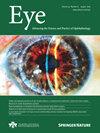Macular, choroidal and disc associations across women’s reproductive life stages: a scoping review from menarche to post-menopause
IF 2.8
3区 医学
Q1 OPHTHALMOLOGY
引用次数: 0
Abstract
Oestrogen and progesterone fluctuate cyclically in women throughout their adult lives. Although these hormones cross the blood-retinal barrier and bind to intraocular receptors, their effects remain unclear. We present the first review to date on associations between posterior pole structures—specifically the macula, choroid, and optic disc—and both the menstrual cycle and post-menopausal period, utilising multimodal imaging techniques in healthy adult non-pregnant women. We excluded studies on contraception and hormonal replacement therapy, focusing solely on physiological associations. Despite the comprehensive scope of our review, limited data and inconsistent reporting among studies prevented the establishment of meaningful trends. Across menstrual cycle phases, choroidal thickness (CHT) was the most consistently reported parameter, with thinning during the luteal phase compared to the follicular phase. Conversely, no significant differences were observed in macular or disc morphology across the cycle, likely reflecting a preserved structure despite potential fluctuations in blood flow and perfusion. Studies comparing pre- and post-menopausal associations, after adjusting for age or body mass index (BMI), failed to reveal meaningful trends, highlighting the difficulty in separating the effect of age from hormonal declines in older women. Understanding how hormonal cycles impact the posterior pole in women is crucial for addressing sex differences in various ocular pathologies. Research on female-specific factors is still sparse, and interestingly, the majority of affiliations in the reviewed articles did not originate from regions with the highest biomedical research funding and publication rates. We encourage further studies focusing on female-specific variables and provide recommendations for future designs.

黄斑、脉络膜和椎间盘在女性生殖生命阶段的关联:从初潮到绝经后的范围回顾。
雌激素和黄体酮在女性的整个成年生活中周期性波动。尽管这些激素穿过血视网膜屏障并与眼内受体结合,但它们的作用尚不清楚。我们利用多模态成像技术对健康成年非孕妇进行了迄今为止首次回顾了后极结构(特别是黄斑、脉络膜和视盘)与月经周期和绝经后期之间的关系。我们排除了避孕和激素替代疗法的研究,只关注生理关联。尽管我们的综述范围广泛,但有限的数据和研究之间不一致的报告阻碍了有意义趋势的建立。在月经周期的各个阶段,脉络膜厚度(CHT)是最一致报道的参数,与卵泡期相比,黄体期变薄。相反,在整个周期中,黄斑或椎间盘形态没有观察到显著差异,可能反映了尽管血流和灌注可能出现波动,但仍保留了结构。在调整年龄或身体质量指数(BMI)后,比较绝经前和绝经后相关性的研究未能揭示有意义的趋势,突出了将年龄的影响与老年妇女激素下降的影响分开的困难。了解激素周期如何影响女性后极对于解决各种眼部疾病的性别差异至关重要。关于女性特定因素的研究仍然很少,有趣的是,在审查的文章中,大多数隶属关系并非来自生物医学研究经费和发表率最高的地区。我们鼓励进一步研究女性特有的变量,并为未来的设计提供建议。
本文章由计算机程序翻译,如有差异,请以英文原文为准。
求助全文
约1分钟内获得全文
求助全文
来源期刊

Eye
医学-眼科学
CiteScore
6.40
自引率
5.10%
发文量
481
审稿时长
3-6 weeks
期刊介绍:
Eye seeks to provide the international practising ophthalmologist with high quality articles, of academic rigour, on the latest global clinical and laboratory based research. Its core aim is to advance the science and practice of ophthalmology with the latest clinical- and scientific-based research. Whilst principally aimed at the practising clinician, the journal contains material of interest to a wider readership including optometrists, orthoptists, other health care professionals and research workers in all aspects of the field of visual science worldwide. Eye is the official journal of The Royal College of Ophthalmologists.
Eye encourages the submission of original articles covering all aspects of ophthalmology including: external eye disease; oculo-plastic surgery; orbital and lacrimal disease; ocular surface and corneal disorders; paediatric ophthalmology and strabismus; glaucoma; medical and surgical retina; neuro-ophthalmology; cataract and refractive surgery; ocular oncology; ophthalmic pathology; ophthalmic genetics.
 求助内容:
求助内容: 应助结果提醒方式:
应助结果提醒方式:


